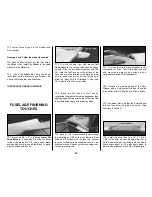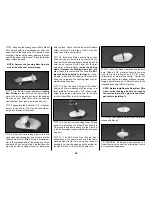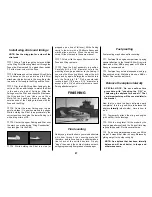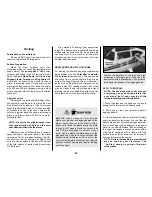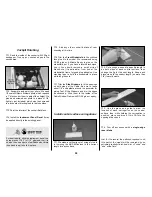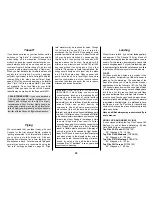
Use a “chicken stick” device or electric
starter; follow instructions supplied with the
starter or stick. Make certain the glow plug clip
or connector is secure so that it will not pop off
or fall into the running propeller.
Make all engine adjustments from
behind
the rotating propeller.
The engine gets hot! Do not touch it during
or directly after operation. Make sure fuel lines
are in good condition so fuel will not leak onto a
hot engine, causing a fire.
To stop the engine, cut off the fuel supply by
closing off the fuel line or follow the engine
manufacturer’s recommendations. Do not use
hands, fingers, or any body part to try to stop the
engine. Do not throw anything into the prop of a
running engine.
Read and abide by the following Academy of
Model Aeronautics Official Safety Code:
1. I will not fly my model aircraft in sanctioned
events, air shows, or model flying demonstrations
until it has been proven to be airworthy by having
been previously successfully flight tested.
2. I will not fly my model aircraft higher than
approximately 400 feet within 3 miles of an
airport without notifying the airport operator. I
will give right of way to, and avoid flying in the
proximity of full-scale aircraft. Where necessary,
an observer shall be used to supervise flying to
avoid having models fly in the proximity of
full- scale aircraft.
3. Where established, I will abide by the safety
rules for the flying site I use and I will not willfully
and deliberately fly my models in a careless,
reckless and/or dangerous manner.
7. I will not fly my model unless it is identified
with my name and address or AMA number, on
or in the model.
9. I will not operate models with pyrotechnics
(any device that explodes, burns, or propels a
projectile of any kind).
1. I will have completed a successful radio
equipment ground check before the first flight of
a new or repaired model.
2. I will not fly my model aircraft in the
presence of spectators until I become a qualified
flier, unless assisted by an experienced helper.
3. I will perform my initial turn after takeoff
away from the pit or spectator areas, and I will
not thereafter fly over pit or spectator areas,
unless beyond my control.
4. I will operate my model using only radio
control frequencies currently allowed by the
Federal Communications Commission...
The Top Flite Cessna 182 Skylane is a great-flying,
sport-scale airplane that flies smoothly and
predictably, yet is highly maneuverable. Compared
to other scale models, its flight characteristics are
quite docile and forgiving. It does not, however,
have the self-recovery characteristics of a primary
R/C trainer; therefore, you must either have
mastered the basics of R/C flying or obtained the
assistance of a competent R/C pilot to help you
until you are able to safely and competently pilot
the model yourself.
Balance your propellers carefully before flying.
An unbalanced prop is the single most
significant cause of damaging vibration. Not only
will engine mounting screws and bolts vibrate
out, possibly with disastrous effect, but vibration
will also damage your radio receiver and battery.
Vibration will cause your fuel to foam, which will,
in turn, cause your engine to run rough or quit.
We use a Top Flite Precision Magnetic Prop
Balancer (TOPQ5700) in the workshop and keep
a Great Planes Fingertip Balancer (GPMQ5000)
in our flight box.
A fully cowled engine will tend to run at a higher
cylinder temperature than an un-cowled engine.
For this reason the fuel mixture should be set to
run the engine at about 200 rpm below peak
(maximum) speed. By r unning the engine
slightly rich you will help prevent dead stick
landings caused by overheating.
Fuel mixture adjustment
Balance the propeller
FLYING
Radio control
General
AMA SAFETY CODE
54
Summary of Contents for CESSNA 182 SKYLANE
Page 8: ...8 DIE CUT PATTERNS ...




